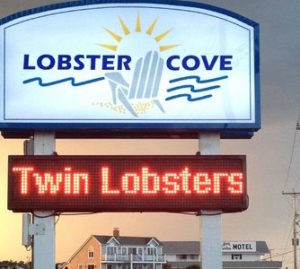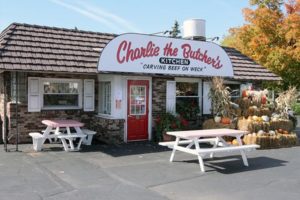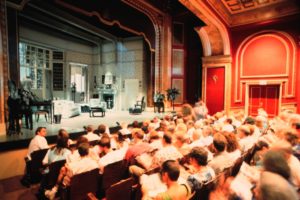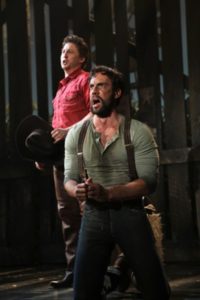 Mrs. T and I usually spend a couple of weeks each summer seeing shows in New England and Canada for The Wall Street Journal. That’s what we’re doing now. On Saturday we drove north from Connecticut to Maine, where we stayed at a seaside hotel, saw a revival of Ragtime that I liked enormously, bought underwear at an outlet mall, and ate lobster three nights in a row. Actually, it was Mrs. T who ate most of the lobster. Born and raised in Connecticut, she has an insatiable appetite for the stuff, and no sooner did the waitress at Lobster Cove bring us our evening meal on Saturday than she tore into it like a serial killer who’d just been sprung from solitary. Me, I stuck to shrimp and the odd lobster roll—I can’t see the point of spending so much time and energy prying dinner out of the red-hot shell of a freshly expired crustacean—but I live to please Mrs. T, so we always make a point of hitting the pounds and shacks when we’re in Maine.
Mrs. T and I usually spend a couple of weeks each summer seeing shows in New England and Canada for The Wall Street Journal. That’s what we’re doing now. On Saturday we drove north from Connecticut to Maine, where we stayed at a seaside hotel, saw a revival of Ragtime that I liked enormously, bought underwear at an outlet mall, and ate lobster three nights in a row. Actually, it was Mrs. T who ate most of the lobster. Born and raised in Connecticut, she has an insatiable appetite for the stuff, and no sooner did the waitress at Lobster Cove bring us our evening meal on Saturday than she tore into it like a serial killer who’d just been sprung from solitary. Me, I stuck to shrimp and the odd lobster roll—I can’t see the point of spending so much time and energy prying dinner out of the red-hot shell of a freshly expired crustacean—but I live to please Mrs. T, so we always make a point of hitting the pounds and shacks when we’re in Maine.
 On Tuesday we checked out of Cliff House and drove to Portland, where we spent a happy hour looking at Hans Hofmann: Works on Paper, a small but exceedingly choice exhibition on view at the Portland Museum of Art until September 3. Hofmann is one of our favorite painters—we actually own one of his rare prints—and we’ve both been longing to see this show, which traveled to Portland from the Museum of Contemporary Art in Jacksonville, Florida, ever since it was announced. (I would have liked to see the John Marin exhibition at the Ogunquit Museum of American Art, too, but I didn’t hear about it until after we’d left town.) I’ll be writing about the Hofmann show in detail later on, so suffice it for now to say that Karen Wilkin, the curator, has done an exemplary job of conveying the vibrant essence of Hofmann’s style within the narrow compass of a one-gallery show devoted solely to his works on paper.
On Tuesday we checked out of Cliff House and drove to Portland, where we spent a happy hour looking at Hans Hofmann: Works on Paper, a small but exceedingly choice exhibition on view at the Portland Museum of Art until September 3. Hofmann is one of our favorite painters—we actually own one of his rare prints—and we’ve both been longing to see this show, which traveled to Portland from the Museum of Contemporary Art in Jacksonville, Florida, ever since it was announced. (I would have liked to see the John Marin exhibition at the Ogunquit Museum of American Art, too, but I didn’t hear about it until after we’d left town.) I’ll be writing about the Hofmann show in detail later on, so suffice it for now to say that Karen Wilkin, the curator, has done an exemplary job of conveying the vibrant essence of Hofmann’s style within the narrow compass of a one-gallery show devoted solely to his works on paper.
From Portland we headed for Utica, New York, a city devoid of any claim to fame, though it used to be so crime-ridden that it came to be known as “the city that God forgot.” We didn’t stop there to see shows—if there’s any professional theater in Utica, I’m not aware of it—but merely to spend the night, several years’ experience having taught me that five hours of driving is all I care to do in one day. The local cuisine, it seems, is Italian, which was fine with me—I’d eaten more than enough seafood by then—so we went to an Italian steakhouse across the parking lot from the Holiday Inn Express, a family-friendly place whose female staff wears black fedoras, whose sound system plays the Complete Works of Dean Martin on an endless loop, and whose food, somewhat to my surprise, was much better than edible.
 We paused in Buffalo on Wednesday to lunch on beef on weck, a regional specialty, at Charlie the Butcher, a wonderful sandwich shop about which I learned from Roadfood. Then we crossed the border and made our way to Niagara-on-the-Lake, the smallish Ontario town that is home to the Shaw Festival, dining on jambalaya and split-pea soup that we’d picked up at Charlie the Butcher, after which we spent the rest of the evening reading in bed.
We paused in Buffalo on Wednesday to lunch on beef on weck, a regional specialty, at Charlie the Butcher, a wonderful sandwich shop about which I learned from Roadfood. Then we crossed the border and made our way to Niagara-on-the-Lake, the smallish Ontario town that is home to the Shaw Festival, dining on jambalaya and split-pea soup that we’d picked up at Charlie the Butcher, after which we spent the rest of the evening reading in bed.
My middle-aged love affair with Canada doesn’t seem to have abated in the slightest. No sooner did we cross the border than I felt completely at home, just as I always feel at ease in the company of my Canadian friends. The vast expanses of pancake-flat farmland and huge blue bowl of sky that surround Niagara-on-the-Lake remind me of southeast Missouri, the place where I grew up, with the slight, almost imperceptible accent and unselfconscious niceness of the locals lending a sweet touch of strangeness to the prevailing sense of familarity. I could imagine living in a town like this.
Save for meeting an old friend for dinner, we spent our first full day in town doing nothing, which suited both of us fine. I’d written three pieces on Monday and seen them into print from the road on Monday and Tuesday, so I was glad to sleep late in our comfortable hotel, eat the excellent food at Zees Grill, read a Donald Westlake novel, and make restaurant reservations for the long weekend to come. By now I have my doubts about how much anyone learns from experience, but I do seem to have figured out at last that it’s smart to build plenty of down time into road trips. I used to make a point of cramming far too much activity into not quite enough time. Now I know better, and Mrs. T is glad for it.
 The Shaw Festival, as I’ve learned over the past few years, is one of the foremost classical theater festivals in North America. We plan to spend the next three days seeing Alan Bennett’s The Madness of George III, Brian Friel’s Dancing at Lughnasa, and Shaw’s Saint Joan, which is a sufficiently stiff dose of serious playgoing for one visit. Unless my resolve slackens, I’ll write up each show immediately after I see it. Then we’ll return to the road on Monday, stopping yet again at Charlie the Butcher and spending another night in Utica en route to New Hampshire, where the Peterborough Players’ production of a second Shaw play, The Doctor’s Dilemma, awaits us.
The Shaw Festival, as I’ve learned over the past few years, is one of the foremost classical theater festivals in North America. We plan to spend the next three days seeing Alan Bennett’s The Madness of George III, Brian Friel’s Dancing at Lughnasa, and Shaw’s Saint Joan, which is a sufficiently stiff dose of serious playgoing for one visit. Unless my resolve slackens, I’ll write up each show immediately after I see it. Then we’ll return to the road on Monday, stopping yet again at Charlie the Butcher and spending another night in Utica en route to New Hampshire, where the Peterborough Players’ production of a second Shaw play, The Doctor’s Dilemma, awaits us.
No, this isn’t a vacation, but we wouldn’t arrange our schedule much differently if it were, and the fact that Mrs. T and I are traveling together is, as always, the best part. I used to travel alone, and thought I liked it well enough. No more: now I can’t imagine swinging through New England and Canada each summer without my beloved spouse at my side. I know what’s good.
* * *
Diana Krall sings “Departure Bay,” written in collaboration with Elvis Costello, at the 2004 Montreal Jazz Festival:

 Three-quarters of a century after it opened on Broadway and ran for a then-unprecedented 2,212 performances, it’s easy to forget that “Oklahoma!” was one of the most innovative and influential of all Broadway musicals, not merely for Agnes de Mille’s oft-imitated dream-ballet sequence but also for the way in which Richard Rodgers and Oscar Hammerstein II integrated their songs into the dramatic flow of Hammerstein’s book. Even more important, Hammerstein built darkness and conflict into what could have been a lightweight show by portraying Jud Fry (Matt Faucher) as a tortured soul who is obsessed with the sexually innocent Laurey (Samantha Bruce). That wasn’t the way musicals worked in 1943—most of them were as fluffy as lemon meringue—but Rodgers and Hammerstein believed that the Broadway musical would never ripen into a serious form of popular art unless it was driven by strong dramatic conflict….
Three-quarters of a century after it opened on Broadway and ran for a then-unprecedented 2,212 performances, it’s easy to forget that “Oklahoma!” was one of the most innovative and influential of all Broadway musicals, not merely for Agnes de Mille’s oft-imitated dream-ballet sequence but also for the way in which Richard Rodgers and Oscar Hammerstein II integrated their songs into the dramatic flow of Hammerstein’s book. Even more important, Hammerstein built darkness and conflict into what could have been a lightweight show by portraying Jud Fry (Matt Faucher) as a tortured soul who is obsessed with the sexually innocent Laurey (Samantha Bruce). That wasn’t the way musicals worked in 1943—most of them were as fluffy as lemon meringue—but Rodgers and Hammerstein believed that the Broadway musical would never ripen into a serious form of popular art unless it was driven by strong dramatic conflict….
